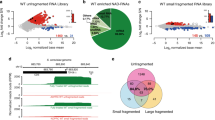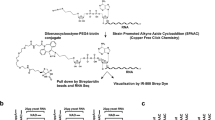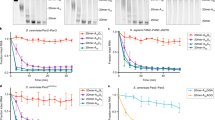Abstract
The nuclear cap–binding complex (CBC) stimulates multiple steps in several RNA maturation pathways, but how it functions in humans is incompletely understood. For small, capped RNAs such as pre-snRNAs, the CBC recruits PHAX. Here, we identify the CBCAP complex, composed of CBC, ARS2 and PHAX, and show that both CBCAP and CBC–ARS2 complexes can be reconstituted from recombinant proteins. ARS2 stimulates PHAX binding to the CBC and snRNA 3′-end processing, thereby coupling maturation with export. In vivo, CBC and ARS2 bind similar capped noncoding and coding RNAs and stimulate their 3′-end processing. The strongest effects are for cap-proximal polyadenylation sites, and this favors premature transcription termination. ARS2 functions partly through the mRNA 3′-end cleavage factor CLP1, which binds RNA Polymerase II through PCF11. ARS2 is thus a major CBC effector that stimulates functional and cryptic 3′-end processing sites.
This is a preview of subscription content, access via your institution
Access options
Subscribe to this journal
Receive 12 print issues and online access
$189.00 per year
only $15.75 per issue
Buy this article
- Purchase on Springer Link
- Instant access to full article PDF
Prices may be subject to local taxes which are calculated during checkout







Similar content being viewed by others
Accession codes
References
Kelly, S.M. & Corbett, A.H. Messenger RNA export from the nucleus: a series of molecular wardrobe changes. Traffic 10, 1199–1208 (2009).
Luna, R., Gaillard, H., González-Aguilera, C. & Aguilera, A. Biogenesis of mRNPs: integrating different processes in the eukaryotic nucleus. Chromosoma 117, 319–331 (2008).
Perales, R. & Bentley, D. “Cotranscriptionality”: the transcription elongation complex as a nexus for nuclear transactions. Mol. Cell 36, 178–191 (2009).
Topisirovic, I., Svitkin, Y., Sonenberg, N. & Shatkin, A. Cap and cap-binding proteins in the control of gene expression. Wiley Interdiscip. Rev. RNA 2, 277–298 (2011).
Rasmussen, E.B. & Lis, J.T. In vivo transcriptional pausing and cap formation on three Drosophila heat shock genes. Proc. Natl. Acad. Sci. USA 90, 7923–7927 (1993).
Cho, E.J., Takagi, T., Moore, C.R. & Buratowski, S. mRNA capping enzyme is recruited to the transcription complex by phosphorylation of the RNA polymerase II carboxy-terminal domain. Genes Dev. 11, 3319–3326 (1997).
McCracken, S. et al. 5′-capping enzymes are targeted to pre-mRNA by binding to the phosphorylated carboxy-terminal domain of RNA polymerase II. Genes Dev. 11, 3306–3318 (1997).
Izaurralde, E. et al. A nuclear cap binding protein complex involved in pre-mRNA splicing. Cell 78, 657–668 (1994).
Flaherty, S.M., Fortes, P., Izaurralde, E., Mattaj, I.W. & Gilmartin, G.M. Participation of the nuclear cap binding complex in pre-mRNA 3′ processing. Proc. Natl. Acad. Sci. USA 94, 11893–11898 (1997).
Boulon, S. et al. PHAX and CRM1 are required sequentially to transport U3 snoRNA to nucleoli. Mol. Cell 16, 777–787 (2004).
Cheng, H. et al. Human mRNA export machinery recruited to the 5′ end of mRNA. Cell 127, 1389–1400 (2006).
Ohno, M., Segref, A., Bachi, A., Wilm, M. & Mattaj, I.W. PHAX, a mediator of U snRNA nuclear export whose activity is regulated by phosphorylation. Cell 101, 187–198 (2000).
Kim, K.M. et al. A new MIF4G domain-containing protein, CTIF, directs nuclear cap-binding protein CBP80/20-dependent translation. Genes Dev. 23, 2033–2045 (2009).
Lewis, J.D., Izaurralde, E., Jarmolowski, A., McGuigan, C. & Mattaj, I.W. A nuclear cap-binding complex facilitates association of U1 snRNP with the cap-proximal 5′ splice site. Genes Dev. 10, 1683–1698 (1996).
Narita, T. et al. NELF interacts with CBC and participates in 3′ end processing of replication-dependent histone mRNAs. Mol. Cell 26, 349–365 (2007).
Ohno, M., Segref, A., Kuersten, S. & Mattaj, I.W. Identity elements used in export of mRNAs. Mol. Cell 9, 659–671 (2002).
Gruber, J.J. et al. ARS2 links the nuclear cap-binding complex to rna interference and cell proliferation. Cell 138, 328–339 (2009).
Boulon, S. et al. HSP90 and its R2TP/Prefoldin-like cochaperone are involved in the cytoplasmic assembly of RNA polymerase II. Mol. Cell 39, 912–924 (2010).
Pabis, M. et al. The nuclear cap-binding complex interacts with the U4/U6•U5 tri-snRNP and promotes spliceosome assembly in mammalian cells. RNA 19, 1054–1063 (2013).
Mourão, A., Varrot, A., Mackereth, C.D., Cusack, S. & Sattler, M. Structure and RNA recognition by the snRNA and snoRNA transport factor PHAX. RNA 16, 1205–1216 (2010).
Barrios-Rodiles, M. et al. High-throughput mapping of a dynamic signaling network in mammalian cells. Science 307, 1621–1625 (2005).
Gruber, J.J. et al. ARS2 promotes proper replication-dependent histone mRNA 3′ end formation. Mol. Cell 45, 87–98 (2012).
Dominski, Z. & Marzluff, W. Formation of the 3′ end of histone mRNA: getting closer to the end. Gene 396, 373–390 (2007).
Preker, P. et al. RNA exosome depletion reveals transcription upstream of active human promoters. Science 322, 1851–1854 (2008).
Seila, A.C. et al. Divergent transcription from active promoters. Science 322, 1849–1851 (2008).
Andersen, P.R. et al. The human cap-binding complex is functionally connected to the nuclear RNA exosome. Nat. Struct. Mol. Biol. 10.1038/nsmb.2703 (24 November 2013).
Chen, J. et al. An RNAi screen identifies additional members of the Drosophila Integrator complex and a requirement for cyclin C/Cdk8 in snRNA 3′-end formation. RNA 18, 2148–2156 (2012).
Hernandez, N. & Weiner, A. Formation of the 3′ end of U1 snRNA requires compatible snRNA promoter elements. Cell 47, 249–258 (1986).
Baillat, D. et al. Integrator, a multiprotein mediator of small nuclear RNA processing, associates with the C-terminal repeat of RNA polymerase II. Cell 123, 265–276 (2005).
Lubas, M. et al. Interaction profiling identifies the human nuclear exosome targeting complex. Mol. Cell 43, 624–637 (2011).
Egloff, S., O'Reilly, D. & Murphy, S. Expression of human snRNA genes from beginning to end. Biochem. Soc. Trans. 36, 590–594 (2008).
Yang, X.C., Burch, B.D., Yan, Y., Marzluff, W.F. & Dominski, Z. FLASH, a proapoptotic protein involved in activation of caspase-8, is essential for 3′ end processing of histone pre-mRNAs. Mol. Cell 36, 267–278 (2009).
Almada, A.E., Wu, X., Kriz, A.J., Burge, C.B. & Sharp, P.A. Promoter directionality is controlled by U1 snRNP and polyadenylation signals. Nature 499, 360–363 (2013).
Kaida, D. et al. U1 snRNP protects pre-mRNAs from premature cleavage and polyadenylation. Nature 468, 664–668 (2010).
Ntini, E. et al. Polyadenylation site–induced decay of upstream transcripts enforces promoter directionality. Nat. Struct. Mol. Biol. 20, 923–928 (2013).
Paushkin, S.V., Patel, M., Furia, B.S., Peltz, S.W. & Trotta, C.R. Identification of a human endonuclease complex reveals a link between tRNA splicing and pre-mRNA 3′ end formation. Cell 117, 311–321 (2004).
de Vries, H. et al. Human pre-mRNA cleavage factor II(m) contains homologs of yeast proteins and bridges two other cleavage factors. EMBO J. 19, 5895–5904 (2000).
Poser, I. et al. BAC TransgeneOmics: a high-throughput method for exploration of protein function in mammals. Nat. Methods 5, 409–415 (2008).
Shi, Y. et al. Molecular architecture of the human pre-mRNA 3′ processing complex. Mol. Cell 33, 365–376 (2009).
Kiriyama, M., Kobayashi, Y., Saito, M., Ishikawa, F. & Yonehara, S. Interaction of FLASH with arsenite resistance protein 2 is involved in cell cycle progression at S phase. Mol. Cell Biol. 29, 4729–4741 (2009).
Gudipati, R.K., Villa, T., Boulay, J. & Libri, D. Phosphorylation of the RNA polymerase II C-terminal domain dictates transcription termination choice. Nat. Struct. Mol. Biol. 15, 786–794 (2008).
Vasiljeva, L., Kim, M., Mutschler, H., Buratowski, S. & Meinhart, A. The Nrd1–Nab3–Sen1 termination complex interacts with the Ser5-phosphorylated RNA polymerase II C-terminal domain. Nat. Struct. Mol. Biol. 15, 795–804 (2008).
Girard, C., Neel, H., Bertrand, E. & Bordonné, R. Depletion of SMN by RNA interference in HeLa cells induces defects in Cajal body formation. Nucleic Acids Res. 34, 2925–2932 (2006).
Boulon, S. et al. HSP90 and its R2TP/Prefoldin-like cochaperone are involved in the cytoplasmic assembly of RNA polymerase II. Mol. Cell 39, 912–924 (2010).
Lubas, M. et al. Interaction profiling identifies the human nuclear exosome targeting complex. Mol. Cell 43, 624–637 (2011).
Lutfalla, G. & Uze, G. Performing quantitative reverse-transcribed polymerase chain reaction experiments. Methods Enzymol. 410, 386–400 (2006).
Boulon, S. et al. The Hsp90 chaperone controls the biogenesis of L7Ae RNPs through conserved machinery. J. Cell Biol. 180, 579–595 (2008).
Acknowledgements
We thank the Functional Proteomics Platform (FPP, Montpellier Languedoc-Roussillon, France) for the use of their instruments. We thank I. Poser (Max Planck Institute Dresden) for the gift of the CLP1-GFP BAC cell line and H. Le Hir (École Normale Supérieure, Paris) and M.S. Kristiansen (University Aarhus) for critical reading of the manuscript. D.L. was supported by a fellowship from the Fondation pour la Recherche Médicale, M.H. was supported by the French Ministère de la Recherche et de la Technologie, and F.P. was supported by La Ligue Nationale Contre le Cancer (LNCC). This work was funded by grants from the Danish National Research Foundation (grant DNRF58) to T.H.J. and from the French Centre National de la Recherche Scientifique, the Association de la Recherche contre le Cancer and the LNCC to E.B.
Author information
Authors and Affiliations
Contributions
M.H., F.P., P.R.A., M.C., D.L., N.E.H.B., M.-C.R., C.V. and E.B. performed the experiments, T.G. and E.B. analyzed the microarray data, F.V. analyzed the proteomic experiment, all authors participated in the conception of the experiments, S.C. supervised the in vitro reconstitution experiment, T.H.J. supervised the ChIP experiment, and E.B. and C.V. wrote the manuscript and supervised the work.
Corresponding authors
Ethics declarations
Competing interests
The authors declare no competing financial interests.
Integrated supplementary information
Supplementary Figure 1 Characterization of the CBCAP complex.
(A) Characterization of anti-PHAX monoclonal antibodies by Western blotting. Samples were from Hela cells treated with siRNAs against PHAX or FFL as control, and analyzed by Western blots using the indicated antibody. (B) GFP-Ars2 is not recruited to LacO arrays by KPNA2-Laci. Micrographs are from U2OS cells bearing a large LacO repeat, co-transfected with GFP-Ars2 and KPNA2-Laci-mCherry and observed by fluorescence microscopy. (C) Protein-protein interactions within the CBCAP complex analyzed by two-hybrid tests. (D) Alignments and domains of human, drosophila, plant and fission yeast Ars2. Schematics indicate putative functional domains of human Ars2.
Supplementary Figure 2 Characterization of the Flp-In cell lines.
(A) Characterization of 3x-Flag-Ars2 and 3xFlag-CBP20 Hela Flip-In cells by Western blotting. Samples are lysates from 3x-Flag-Ars2 and 3xFlag-CBP20 Flp-In cells analyzed by Western blotting with anti-Flag, anti-Ars2 and anti-GAPDH antibodies as indicated. Arrows: the Flag-tagged protein. Stars: non-specific binding of the antibodies. Ct: control parental cell line. (B) Efficiency of 3xFlag immunoprecipitation analyzed by Western blotting. Samples are lysates (Input) of 3xFlag-Ars2 Flp-In cells (Ars2) or control cells (Ct), expressing 3x-Flag-Ars2, immunopurified with anti-Flag antibodies (IP), and analyzed with anti-Flag antibodies. Sup: supernatants from the IP; W: last wash of the beads. Input, Sups, W: 10% of pellet. (C) Comparison of the enrichment of capped and uncapped non-coding RNAs in the various IPs. Values are enrichment fold from the microarray analysis. Control IP is from parental Flp-In cells that express no tagged protein.
Supplementary Figure 3 Identification and characterization of the RNAs present in the CBP20 and Ars2 Flag IPs.
(A) Analysis of the RNAs enriched in one IP but not in the other. For an IP “X”, the list of RNA enriched in the IP “X” (value greater than mean plus 1,5 STD) but not in the IP “Y” (value lower than mean plus 1,5 STD) was established, and the number represent the enrichment of these RNAs in the IP “Y”. In parenthesis: p Values. (B) Enrichment of specific RNA families in the various IPs. Numbers represent the mean enrichment value for the indicated family, calculated from the microarray data (Log2[enrichment of the specific IP/control IP]). In parenthesis: p Values.
Supplementary Figure 4 Depletion of CBC and Ars2 induces readthrough of U11 and U3 processing sites.
(A) Ars2 depletion and tiling array analysis of RNAs. Samples are from Hela cells treated with Ars2 or control siRNAs, analyzed by tiling microarrays using random-primed libraries (biological triplicates). The graph corresponds to the region of the U11 gene. Transcription from left to right. Bottom: chromosome coordinates. (B) Readthrough assay for U3 terminator and luciferase activity. Samples are from lysates of Hela cells transfected with a U3 plasmid and the indicated siRNAs, and values represent Firefly luciferase activity expressed as ratio over a co-transfected Renilla reporter plasmid.
Supplementary Figure 5 Depletion of CBC and Ars2 induces readthrough of CNIH4 and NR3C1 poly(A) sites.
(A) Read-through assays for of the CNIH4 polyA site and luciferase activity. Samples are lysates from Hela cells transfected with a CNIH4-luciferase plasmid and the indicated siRNAs, and values represent Firefly luciferase activity expressed as ratio over a co-transfected Renilla reporter plasmid. (B) Schematic of the NR3C1 cryptic polyA region. Four potential AAUAAA-like hexamers, with the mutants generated, are depicted. (C) Read-through assays for the NR3C1 polyA region and measurments of RNA levels by RT-qPCR. Samples are from Hela cells transfected with the indicated plasmid and siRNAs, and values represent readthrough RNA levels expressed as ratio of an upstream amplicon, measured by RT-qPCR.
Supplementary Figure 6 Association of CLP1 with RNA polymerase II and uncropped gels of main figures.
(A) CLP1 co-precipitation with RNA Pol II and Western blot analysis. Samples are lysates from Hela cells transfected with a vector expressing GFP-CLP1, immunoprecipitated with anti-GFP antibodies, and analyzed by Western blotting with an antibody against RBP1 (the largest RNA pol II subunit). Input: 5% of pellets. (B-C) Uncropped gels of Figure 1B. (D-E) Uncropped gels of Figure 6B. (F-G) Uncropped gels of Figure 6C.
Supplementary Figure 7 Efficiency of siRNA treatments and P values of luciferase assays.
(A) Samples are lysates from HeLa cells transfected with the indicated siRNAs and analyzed by Western blots with the indicated antiodies. Stars: non-specific bands used as loading controls. (B) p Values of the luciferase assays shown in Figure 7A. Values represent probabilities calculated with two-sided t-tests.
Supplementary information
Supplementary Text and Figures
Supplementary Figures 1–7 and Supplementary Table 2 (PDF 5905 kb)
Supplementary Table 1
Excel spreadsheet containing the ‘all genes’ microarray/IP data, as well as the results of the GFP-CLP1 SILAC proteomic experiment (XLSX 591 kb)
Rights and permissions
About this article
Cite this article
Hallais, M., Pontvianne, F., Andersen, P. et al. CBC–ARS2 stimulates 3′-end maturation of multiple RNA families and favors cap-proximal processing. Nat Struct Mol Biol 20, 1358–1366 (2013). https://doi.org/10.1038/nsmb.2720
Received:
Accepted:
Published:
Issue Date:
DOI: https://doi.org/10.1038/nsmb.2720
This article is cited by
-
Temporal-iCLIP captures co-transcriptional RNA-protein interactions
Nature Communications (2023)
-
The SMN complex drives structural changes in human snRNAs to enable snRNP assembly
Nature Communications (2023)
-
The 3′ Pol II pausing at replication-dependent histone genes is regulated by Mediator through Cajal bodies’ association with histone locus bodies
Nature Communications (2022)
-
The PNUTS-PP1 complex acts as an intrinsic barrier to herpesvirus KSHV gene expression and replication
Nature Communications (2022)
-
A transcriptome-wide antitermination mechanism sustaining identity of embryonic stem cells
Nature Communications (2020)



